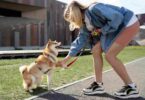Planning an escapade with your furry companion? Training dogs for outdoor adventures is not just an afterthought; it’s a vital step in ensuring that your explorations—be it hiking through verdant forests or camping beneath a twinkling sky—are both enjoyable and safe. A well-trained dog transforms any adventure into an unforgettable experience!
The Importance of Training for Outdoor Excursions
Training your dog goes far beyond simply teaching them to fetch a stick or sit on command. It lays the groundwork for responsible behavior in a variety of settings. Here’s why it’s crucial:
- Safety First: An obedient dog is less likely to dash into danger or stray from your side.
- Enhanced Control: A trained dog listens attentively on a leash, minimizing the risk of wandering off.
- Boosting Confidence: A well-prepared dog remains calm and collected in unfamiliar environments, easing their transition into new experiences.
Master the Basics Before You Hit the Trails
Before embarking on your outdoor adventure, ensure your dog is well-versed in basic commands, such as:
- Sit: This foundational command fosters self-control and composure.
- Stay: Essential for keeping your dog stationary when necessary.
- Come: A lifesaving command that’s pivotal during excursions.
Practice these commands in a quiet space like your backyard to establish a solid training base.
Socialization: A Game-Changer for Adventures
Socializing your dog is transformative. Introduce them to diverse environments, people, and other dogs to minimize anxiety in new settings.
- Varied Environments: Take your dog to parks, pet stores, or friends’ homes to expand their horizons.
- Structured Settings: Enroll in dog training classes to provide controlled socialization opportunities.
This exposure primes your dog for the various stimuli they’ll encounter on your adventures.
Mastering Leash Training: A Safety Must
A well-trained dog on a leash is crucial for their safety and yours. Here are some strategies to improve leash manners:
- Start Small: Begin with short, steady walks in familiar areas at a leisurely pace.
- Positive Reinforcement: Reward good leash behavior with treats, turning walks into a positive experience.
- Loose Leash Walking: Train your dog to walk without pulling; this creates a more enjoyable outing for both of you.
These techniques will help you maintain control during your outdoor escapades.
Kickstart Your Adventure Training
Once your dog has mastered the basics and leash training, it’s time to delve into specific skills for outdoor adventures.
1. Hiking
Begin with shorter trails that allow your dog to acclimate to nature. Keep these tips in mind:
- Pack the Essentials: Always bring water, food, and poop bags—don’t leave home without them!
- Know Your Trail: Choose routes that minimize distractions to keep your dog focused.
- Use the ‘Leave It’ Command: This is crucial when wildlife or distractions arise on the trail.
2. Camping
Camping introduces new challenges, so pre-training is essential.
- Establish a Camp Routine: Teach your dog their designated sleeping area and relaxation zone.
- Handle Noises: Expose them to sounds like crackling campfires or rustling winds to help them adapt.
- Sit Training at Campsites: A solid “sit” command is especially handy amidst the bustle of a busy campsite.
3. Swimming
Planning on taking a dip with your dog? Early training is crucial.
- Get Them Acquainted: Teach your dog how to enter and exit the water safely.
- Safety Gear: Consider investing in a doggie life jacket, particularly for inexperienced swimmers.
- Monitor Swimming Comfort: Observe their swimming habits and comfort level in deeper water.
The Impact of Treats and Praise
Positive reinforcement plays a vital role in your training journey. Here’s how to effectively reward your dog:
- Small Bite-Sized Treats: These are easy for your dog to eat and won’t distract from the training focus.
- Toys: Engaging them in play can be a fun reward for good behavior.
- Affection and Praise: Never underestimate the power of verbal praise and petting when they follow commands.
Remember, training should be an enjoyable endeavor for both you and your dog!
Stay Hydrated and Take Breaks
An active adventure requires keeping your dog well-hydrated. Dogs can become thirsty, especially after exertion.
- Regular Water Breaks: Carry a portable dog bowl for quick hydration stops.
- Rest Periods: Schedule breaks during longer hikes to help your pup recharge.
Maintaining your dog’s comfort ensures they remain enthusiastic about future outings.
Patience is Key: Start Slow
Every dog has a unique learning curve, so patience is paramount. Don’t rush the process.
- Short Training Sessions: Limit sessions to 15-20 minutes to keep your dog focused and engaged.
- Positive Endings: Conclude sessions with a command they excel at, leaving them feeling accomplished.
Conclusion
Taking your dog on outdoor adventures can forge unbreakable bonds. By prioritizing training for these excursions, you set the stage for safe, enjoyable experiences. Emphasize socialization, basic commands, and good behavior to ensure your trips are filled with happy memories. Remember, both of you should relish the training process as much as the adventures that await!
Happy adventuring with your furry friend!


